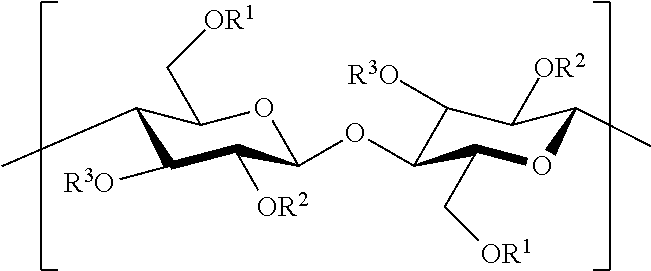Cellulose ester and polymeric aliphatic polyester compositions and articles
a technology of polymeric aliphatic polyester and cellulose ester, which is applied in the field of cellulose ester chemistry, can solve the problems of reducing the toughness of high tg cellulosic compositions, and achieve the effects of reducing the amount of monomeric plasticizer, good clarity and toughness, and eliminating the use of monomeric plasticizers
- Summary
- Abstract
- Description
- Claims
- Application Information
AI Technical Summary
Benefits of technology
Problems solved by technology
Method used
Image
Examples
example 1
and Without Monomeric Plasticizer
[0155]CAP grades from Table 1 without any monomeric plasticizer (Ex. 1-1) and with 10% DOA plasticizer (Ex. 1-2) were each injection molded into 3.2 mm thick by 12.8 mm wide bars on a Toyo 110 Ton injection molding machine with barrel temperature of 240° C. and mold temperature of 70° C.
[0156]The clarity, melt viscosity, Tg and Izod Impact strength were determined for each sample. The compositions and properties of the materials for Examples 1-1 and 1-2 are listed below in table 3.
TABLE 3Clear, CAP materials with and without monomeric plasticizer.NotchedIzodImpactMonomericMonomericStrengthEx.CEplasticizerplasticizerTgFlexural@23 C.,1gradesGrades%clarity(° C.)modulusJ / m1482-200Clear147210070.92482-20DOA10Clear10812003123141-200clear174310045.5
[0157]Table 3 shows properties of CAP 482-20 blended without (Ex 1-1) and with monomeric plasticizer (Ex 1-2), and CAP 141-20 without monomeric plasticizer (Ex. 1-3). A review of the table reveals that the plasti...
example 2
S Blends
[0158]Different cellulose ester grades (from Table 1) were blended with different grades and different amounts of PBS polymers and were injection molded into 3.2 mm thick by 12.8 mm wide bars on a Toyo 110 Ton injection molding machine with barrel temperature of 240° C. and mold temperature of 70° C.
[0159]The clarity, flexural modulus, Tg and notched Izod Impact strength were determined for each sample. The compositions and properties of the materials for Example 2 are listed below in table 4.
TABLE 4CE and PBS polymer blendsNotchedIzodImpactStrengthEx.CEPBS%Flexural@23 C.,2gradesgradePBSclarityTgmodulusJ / m1482-20FD9210Clear12021021402482-20803S10Clear1202032973482-20803S20Clear83X215.84141-20FD915Clear17229831165141-20FD9110Clear1683026986141-20FD9115Clear16226601127141-20FZ715Clear16128021128141-20FZ7110Clear16631911109141-20FZ7115Clear161244511410141-20803S10Clear172283511611141-3 FD9210Clear172263219612141-8 FD9210Clear172278121113141-20FD9210Clear172298321214141-20803S25...
example 3
olymer and Impact Modifier Blends
[0161]CAP 482-20 cellulose ester grade was blended with different grades of PBS polymers and impact modifiers, and were injection molded into 3.2 mm thick by 12.8 mm wide bars on a Toyo 110 Ton injection molding machine with barrel temperature of 240° C. and mold temperature of 70° C.
[0162]The clarity, flexural modulus, and Izod Impact strength were determined for each sample. The compositions and properties of the materials for Example 3 are listed below in table 5.
TABLE 5Blends of CE, PBS and impact modifiers.NotchedIzodImpactInstrumentFlexuralstrengthEx.PBSPBSImpactIMImpactmodulus@23 C.,3GradesWt %modifierWt %clarityfailure(MPa)J / m1803S10%M5706%clearTough18282512FD9210%M5706%clearTough17382113FD9210%Blendex10% opaqueTough16662043384FD9210%MBS6%clearTough1762232Kane Ace M570 acrylic and B564 MBS core shell impact modifiers were obtained from Kaneka. Blendex 338 ABS core shell impact modifier was obtained from Galata Chemicals.
[0163]A review of tabl...
PUM
| Property | Measurement | Unit |
|---|---|---|
| Tg | aaaaa | aaaaa |
| notched Izod impact strength | aaaaa | aaaaa |
| Tg | aaaaa | aaaaa |
Abstract
Description
Claims
Application Information
 Login to View More
Login to View More - R&D
- Intellectual Property
- Life Sciences
- Materials
- Tech Scout
- Unparalleled Data Quality
- Higher Quality Content
- 60% Fewer Hallucinations
Browse by: Latest US Patents, China's latest patents, Technical Efficacy Thesaurus, Application Domain, Technology Topic, Popular Technical Reports.
© 2025 PatSnap. All rights reserved.Legal|Privacy policy|Modern Slavery Act Transparency Statement|Sitemap|About US| Contact US: help@patsnap.com

